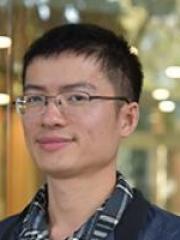Dr Songcan Wang

Researcher biography
Research Focus
Dr. Songcan Wang’s research is mainly focused on the design of functional nanomaterials for energy conversion and storage including photoelectrochemical/photocatalytic water splitting, CO2 reduction, and rechargeable batteries.
Biography
Dr. Songcan Wang is currently a postdoctoral research fellow at School of Chemical Engineering, the University of Queensland, Australia. He received his B.E. and M.E. degrees from Central South University, China, in 2011 and 2014, respectively, and PhD degree from The University of Queensland, Australia, in 2018. He has done intensive work on the design of low-cost and efficient photoelectrodes for photoelectrochemical water splitting and has published over 40 peer reviewed journal articles including top ranking journals such as Chem. Rev., Angew. Chem. Int. Ed., Adv. Mater., Adv. Energy Mater., Adv. Funct. Mater., Nano Energy, 2 book chapters, and delivered around 10 oral presentations in scientific conferences. As a recent PhD graduate, his publications have attracted more than 1050 citations with an H-index of 18 (Google Scholar, 9th May 2019). He is also a reviewer for some journals including Journal of Materials Science & Technology, Journal of Nanoparticle Research, Applied Surface Science, Optics and Laser Technology, and New Journal of Chemistry.
Selected publications
1. S. Wang, G. Liu* and L. Wang*. Crystal Facet Engineering of Photoelectrodes for Photoelectrochemical Water Splitting. Chem. Rev., 2019, 119, 5192-5247.
2. Y. Yang#, S. Wang#, Y. Jiao, Z. Wang, M. Xiao, A. Du, Y. Li, J. Wang* and L. Wang*. An Unusual Red Carbon Nitride to Boost the Photoelectrochemical Performance of Wide Bandgap Photoanodes. Adv. Funct. Mater., 2018, 28, 1805698.
3. S. Wang, P. Chen, Y. Bai, J. H. Yun, G. Liu* and L. Wang*. New BiVO4 Dual Photoanodes with Enriched Oxygen Vacancies for Efficient Solar-Driven Water Splitting. Adv. Mater., 2018, 30, 1800486.
4. S. Wang, T. He, J.-H. Yun, Y. Hu, M. Xiao, A. Du and L. Wang*. New Iron-Cobalt Oxide Catalysts Promoting BiVO4 Films for Photoelectrochemical Water Splitting. Adv. Funct. Mater., 2018, 28, 1802685.
5. P. Wang#, S. Wang#, H. Wang*, Z. Wu and L. Wang*. Recent Progress on Photo-Electrocatalytic Reduction of Carbon Dioxide. Part. Part. Syst. Charact., 2018, 35, 1700371.
6. S. Wang, J.-H. Yun and L. Wang*. Nanostructured Semiconductors for Bifunctional Photocatalytic and Photoelectrochemical Energy Conversion. Semicond. Semimetals, 2017, 97, 315-347.
7. Y. Yang#, S. Wang#, Y. Li, J. Wang* and L. Wang*. Strategies for Efficient Solar Water Splitting Using Carbon Nitride. Chem. Asian J., 2017, 12, 1421-1434.
8. S. Wang, J. H. Yun, B. Luo, T. Butburee, P. Peerakiatkhajohn, S. Thaweesak, M. Xiao and L. Wang*. Recent Progress on Visible Light Responsive Heterojunctions for Photocatalytic Applications. J. Mater. Sci. Technol., 2017, 33, 1-22.
9. S. Wang, P. Chen, J. H. Yun, Y. Hu and L. Wang*. An Electrochemically Treated BiVO4 Photoanode for Efficient Photoelectrochemical Water Splitting. Angew. Chem. Int. Ed., 2017, 56, 8500-8504.
10. S. Wang, H. Chen, G. Gao, T. Butburee, M. Lyu, S. Thaweesak, J. H. Yun, A. Du, G. Liu* and L. Wang*. Synergistic crystal facet engineering and structural control of WO3 films exhibiting unprecedented photoelectrochemical performance. Nano Energy, 2016, 24, 94-102.
